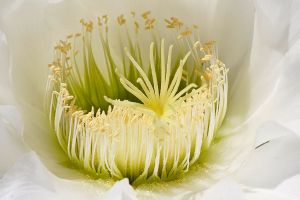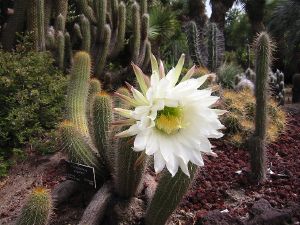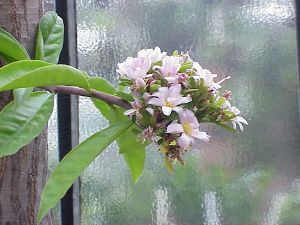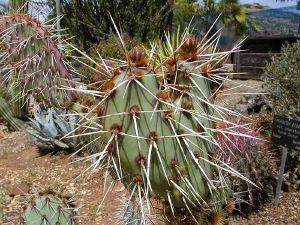Difference between revisions of "Cactus" - New World Encyclopedia
(→Adaptations to dry environment: reference did not say that, was very short anyway) |
|||
| Line 20: | Line 20: | ||
Cacti are distinctive and unusual plants, which are adapted to extremely [[arid]] and hot [[Natural environment|environment]]s, showing a wide range of [[Anatomy|anatomical]] and [[Physiology|physiological]] features which conserve water. Their stems have expanded into green [[succulent]] structures containing the [[chlorophyll]] necessary for life and growth, while the leaves have become the spines for which cacti are so well known. | Cacti are distinctive and unusual plants, which are adapted to extremely [[arid]] and hot [[Natural environment|environment]]s, showing a wide range of [[Anatomy|anatomical]] and [[Physiology|physiological]] features which conserve water. Their stems have expanded into green [[succulent]] structures containing the [[chlorophyll]] necessary for life and growth, while the leaves have become the spines for which cacti are so well known. | ||
| − | Cacti come in a wide range of shapes and sizes. The tallest is | + | Cacti come in a wide range of shapes and sizes. The tallest is ''Pachycereus pringlei'' of northern Mexico, with a maximum recorded height of 19.2 meters (63 feet) (Salak 2000) and the smallest is ''Blossfeldia liliputiana'' of South America, which is only about 1 cm (0.4 inches) in diameter at maturity (Mauseth 2007). Cactus [[flower]]s are large, and like the spines and branches arise from [[areole]]s. Many cactus species are night blooming, as they are [[pollination|pollinated]] by [[nocturnal]] [[insect]]s or small animals, principally moths, bats, and sheep. Cacti's sizes range from small and round to pole-like and tall. |
==Description== | ==Description== | ||
[[Image:Cactus flower closeup03.jpg|thumb|left|Closeup image of a cactus flower (''[[Echinopsis spachiana]]'') showing large number of stamens.]] | [[Image:Cactus flower closeup03.jpg|thumb|left|Closeup image of a cactus flower (''[[Echinopsis spachiana]]'') showing large number of stamens.]] | ||
| − | The cacti are succulent plants that grow either as trees, shrubs or in the form of ground cover. Most species grow on the ground, but there is also a whole range of [[epiphytic]] species. In most species, except for the sub-family of the [[Pereskioideae]] (see image), the leaves are greatly or entirely reduced. The flowers, mostly radially symmetrical and hermaphrodite, bloom either by day or by night, depending on species. Their shape varies from tube-like through bell-like to wheel-shaped, and their size from 0.2 to 15-30 meters. Most of them have numerous [[sepal]]s (from 5 to 50 or more), and change form from outside to inside, from [[bract]]s to [[petal]]s. They have [[stamen]]s in great numbers (from 50 to 1,500, rarely fewer). Nearly all species of cacti have a bitter milk-like substance contained within them. The berry-like fruits may contain few, but mostly many (3,000), seeds, which can be between 0.4 and 12 mm long. | + | The cacti are succulent plants that grow either as trees, shrubs or in the form of ground cover. Most species grow on the ground, but there is also a whole range of [[epiphytic]] species. In most species, except for the sub-family of the [[Pereskioideae]] (see image), the leaves are greatly or entirely reduced. The flowers, mostly radially symmetrical and hermaphrodite, bloom either by day or by night, depending on species. Their shape varies from tube-like through bell-like to wheel-shaped, and their size from 0.2 to 15-30 meters. Most of them have numerous [[sepal]]s (from 5 to 50 or more), and change form from outside to inside, from [[bract]]s to [[petal]]s. They have [[stamen]]s in great numbers (from 50 to 1,500, rarely fewer). Nearly all species of cacti have a bitter milk-like substance contained within them. The berry-like fruits may contain few, but mostly many (3,000), seeds, which can be between 0.4 and 12 mm long. |
The life of a cactus is seldom longer than 300 years, and there are cacti which live only 25 years (although these flower as early as their second year). The Saguaro cactus (''[[Carnegiea gigantea]]'') grows to a height of up to 15 metres (the record is 17 metres 67cm), but in its first ten years it grows only 10 centimetres. The "mother-in-law's cushion" (''[[Echinocactus grusonii]]'') reaches a height of 2.5 meters and a diameter of 1 meter and - at least on the [[Canary Islands|Canaries]] - is already capable of flowering after 6 years. The diameter of cactus flowers ranges from 5 to 30 cm; the colors are often conspicuous and spectacular. | The life of a cactus is seldom longer than 300 years, and there are cacti which live only 25 years (although these flower as early as their second year). The Saguaro cactus (''[[Carnegiea gigantea]]'') grows to a height of up to 15 metres (the record is 17 metres 67cm), but in its first ten years it grows only 10 centimetres. The "mother-in-law's cushion" (''[[Echinocactus grusonii]]'') reaches a height of 2.5 meters and a diameter of 1 meter and - at least on the [[Canary Islands|Canaries]] - is already capable of flowering after 6 years. The diameter of cactus flowers ranges from 5 to 30 cm; the colors are often conspicuous and spectacular. | ||
| Line 46: | Line 46: | ||
[[Image:Pereskia grandifolia3.jpg|thumb|''Pereskia grandifolia'': ''[[Pereskia]]'' is a weakly succulent genus, which also possesses leaves, and is believed to be very similar to the ancestor of all cacti.]] | [[Image:Pereskia grandifolia3.jpg|thumb|''Pereskia grandifolia'': ''[[Pereskia]]'' is a weakly succulent genus, which also possesses leaves, and is believed to be very similar to the ancestor of all cacti.]] | ||
| − | Cacti have never lost their leaves completely; they have only reduced the size so that they reduce the surface area through which water can be lost by transpiration. In some species the leaves are still remarkably large and ordinary while in other species they have became microscopic but they still contain the [[stomata]], [[xylem]] and [[phloem]]. Certain cactus species have also developed [[ephemeral]] leaves, which are leaves that last for a short period of time when the stem is still in his early stages of development. A good example of a species that have ephemeral leaves is the ''Opunta ficus indicia'' better known as the prickly pear. Cactus have also developed [[spine (biology)|spines]] which allow less water to evaporate through [[transpiration]] by shading the plant, and defend the cactus against water-seeking animals. The spines grow from specialized structures called [[areole]]s. Very few members of the family have leaves, and when present these are usually rudimentary and soon fall off; they are typically awl-shaped and only 1-3 mm long. | + | Cacti have never lost their leaves completely; they have only reduced the size so that they reduce the surface area through which water can be lost by transpiration. In some species the leaves are still remarkably large and ordinary while in other species they have became microscopic but they still contain the [[stomata]], [[xylem]] and [[phloem]]. Certain cactus species have also developed [[ephemeral]] leaves, which are leaves that last for a short period of time when the stem is still in his early stages of development. A good example of a species that have ephemeral leaves is the ''Opunta ficus indicia'' better known as the prickly pear. Cactus have also developed [[spine (biology)|spines]] which allow less water to evaporate through [[transpiration]] by shading the plant, and defend the cactus against water-seeking animals. The spines grow from specialized structures called [[areole]]s. Very few members of the family have leaves, and when present these are usually rudimentary and soon fall off; they are typically awl-shaped and only 1-3 mm long. |
[[Image:Cactus1web.jpg|thumb|left|Many species of cactus have long, sharp [[spine (botany)|spines]].]] | [[Image:Cactus1web.jpg|thumb|left|Many species of cactus have long, sharp [[spine (botany)|spines]].]] | ||
Revision as of 22:27, 25 November 2007
| Cacti | ||||||||||
|---|---|---|---|---|---|---|---|---|---|---|
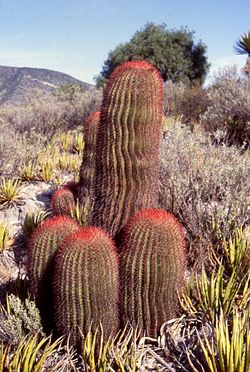 Ferocactus pilosus (Mexican Lime Cactus) growing south of Saltillo, Coahuila, northeast Mexico
| ||||||||||
| Scientific classification | ||||||||||
| ||||||||||
|
See Taxonomy of the Cactaceae |
A cactus (plural cacti, cactuses or cactus) is any member of the succulent plant family Cactaceae, native to the Americas. They are often used as ornamental plants, but some are also crop plants.
Cacti are distinctive and unusual plants, which are adapted to extremely arid and hot environments, showing a wide range of anatomical and physiological features which conserve water. Their stems have expanded into green succulent structures containing the chlorophyll necessary for life and growth, while the leaves have become the spines for which cacti are so well known.
Cacti come in a wide range of shapes and sizes. The tallest is Pachycereus pringlei of northern Mexico, with a maximum recorded height of 19.2 meters (63 feet) (Salak 2000) and the smallest is Blossfeldia liliputiana of South America, which is only about 1 cm (0.4 inches) in diameter at maturity (Mauseth 2007). Cactus flowers are large, and like the spines and branches arise from areoles. Many cactus species are night blooming, as they are pollinated by nocturnal insects or small animals, principally moths, bats, and sheep. Cacti's sizes range from small and round to pole-like and tall.
Description
The cacti are succulent plants that grow either as trees, shrubs or in the form of ground cover. Most species grow on the ground, but there is also a whole range of epiphytic species. In most species, except for the sub-family of the Pereskioideae (see image), the leaves are greatly or entirely reduced. The flowers, mostly radially symmetrical and hermaphrodite, bloom either by day or by night, depending on species. Their shape varies from tube-like through bell-like to wheel-shaped, and their size from 0.2 to 15-30 meters. Most of them have numerous sepals (from 5 to 50 or more), and change form from outside to inside, from bracts to petals. They have stamens in great numbers (from 50 to 1,500, rarely fewer). Nearly all species of cacti have a bitter milk-like substance contained within them. The berry-like fruits may contain few, but mostly many (3,000), seeds, which can be between 0.4 and 12 mm long.
The life of a cactus is seldom longer than 300 years, and there are cacti which live only 25 years (although these flower as early as their second year). The Saguaro cactus (Carnegiea gigantea) grows to a height of up to 15 metres (the record is 17 metres 67cm), but in its first ten years it grows only 10 centimetres. The "mother-in-law's cushion" (Echinocactus grusonii) reaches a height of 2.5 meters and a diameter of 1 meter and - at least on the Canaries - is already capable of flowering after 6 years. The diameter of cactus flowers ranges from 5 to 30 cm; the colors are often conspicuous and spectacular.
Taxonomy
The family of the Cactaceae, with an age of a few million years, is counted as a relatively young plant family, of which no fossil finds are known. Within this short time span (short at any rate from a geological point of view) the cactuses have undergone a rapid development into extremely specialised plants.
The family of the Cactaceae with approx. 2,000-3,000 species and varieties in about 60 genera was originally native to the American continent, where their range extends from Patagonia to the Canadian–American border. Cacti inhabit the most diverse regions, from coastal plains to high mountain areas, from the sub-tropics to the deserts. The most dense occurrence of cactuses is to be found in the territories around north Mexico and the southern tropic (Argentina and Bolivia). The equivalent plants to cactuses in Africa and Australia are representatives of the so-called "other succulents". Occurrences of cacti outside the Americas are the result of distribution by humans (or in very rare cases by migrating birds).
Distribution
Cacti are almost exclusively New World plants. This means that they are native only in North America, South America, and the West Indies. There is however one exception, Rhipsalis baccifera; this species has a pantropical distribution, occurring in the Old World tropical Africa, Madagascar and Sri Lanka as well as in tropical America. This plant is thought to be a relatively recent colonist in the Old World (within the last few thousand years), probably carried as seeds in the digestive tracts of migratory birds. Many other cacti have become naturalized to similar environments in other parts of the world after being introduced by people.
Cacti are believed to have evolved in the last 30 to 40 million years. Long ago, the Americas were joined to the other continents, but separated due to continental drift. Unique species in the New World must have developed after the continents had moved apart. Significant distance between the continents was only achieved in around the last 50 million years. This may explain why cacti are so rare in Africa; the continents had already separated when cacti evolved. Many succulent plants in both the Old and New World bear a striking resemblance to cacti, and are often called "cactus" in common usage. This is, however, due to parallel evolution; none of these are closely related to the Cactaceae.
Prickly pears (genus Opuntia) were imported into Australia in the 19th century to be used as a natural agricultural fence and to establish an cochineal dye industry, but quickly became a widespread weed. This invasive species is inedible for local herbivores and has rendered 40,000 km² of farming land unproductive.
Adaptations to dry environment
Some environments, such as deserts, semi-deserts and dry steppes, receive little water in the form of precipitation. Plants that inhabit these dry areas are known as xerophytes, and many of them are succulents, with thick or reduced, "succulent", leaves. Apart from a very few exceptions (for example, the genus "Rhodocactus") all cactuses are succulent plants, although not all succulent plants are cacti. Like other succulents, these cacti have a range of specific adaptations that enable them to survive in these environments.
Cacti have never lost their leaves completely; they have only reduced the size so that they reduce the surface area through which water can be lost by transpiration. In some species the leaves are still remarkably large and ordinary while in other species they have became microscopic but they still contain the stomata, xylem and phloem. Certain cactus species have also developed ephemeral leaves, which are leaves that last for a short period of time when the stem is still in his early stages of development. A good example of a species that have ephemeral leaves is the Opunta ficus indicia better known as the prickly pear. Cactus have also developed spines which allow less water to evaporate through transpiration by shading the plant, and defend the cactus against water-seeking animals. The spines grow from specialized structures called areoles. Very few members of the family have leaves, and when present these are usually rudimentary and soon fall off; they are typically awl-shaped and only 1-3 mm long.
Enlarged stems carry out photosynthesis and store water. Unlike many other succulents, the stem is the only part of a true cactus where this takes place. Much like many other plants that have waxy coatings on their leaves, Cacti often have a waxy coating on their stems to prevent water loss. This works by preventing water from spreading on the surface and allowing water to trickle down the stem to be absorbed by the roots and used for photosynthesis.
The bodies of many cacti have become thickened during the course of evolution, and form water-retentive tissue and in many cases assume the optimal shape of the sphere (combining highest possible volume with lowest possible surface area). By reducing its surface area, the body of the plant is also protected against excessive sunlight.

Most cacti have a short growing season and long dormancy. For example, a fully-grown Saguaro cactus (Carnegiea gigantea) can absorb up to 3,000 litres of water in ten days. This is helped by cacti's ability to form new roots quickly. Only two hours after rain following a relatively long drought the formation of new roots begins. Apart from a few exceptions an extensively ramified root system is formed, which spreads out immediately beneath the surface. The salt concentration in the root cells is relatively high, so that when moisture is encountered, water can immediately be absorbed in the greatest possible quantity.
But the plant body itself is also capable of absorbing moisture (through the epidermis and the thorns), which for plants that are exposed to moisture almost entirely, or indeed in some cases solely, in the form of fog, is of the greatest importance for sustaining life.
Most cacti have very shallow roots that can spread out widely close to the surface of the ground to collect water, an adaptation to infrequent rains; in one examination, a young Saguaro only 12 cm tall had a root system covering an area 2 meters in diameter, but with no roots more than 10 cm deep.[1] The larger columnar cacti also develop a taproot, primarily for anchoring but also to reach deeper water supplies and mineral nutrients.[1]
One feature distinguishes the cactuses from all other plants: cactuses possess areoles, as they are known. The areole appears like a cushion with a diameter of up to 15 mm and is formed by two opposing buds in the angles of a leaf. From the upper bud develops either a blossom or a side shoot, from the lower bud develop thorns. The two buds of the areoles can lie very close together, but they can also sometimes be separated by several centimetres.
Like other succulents in the families of the Crassulaceae, Agavaceae (agaves), Euphorbiaceae (euphorbias), Liliaceae (lilies), Orchidaceae (orchids) and Vitaceae (vines), cacti reduce water loss through transpiration by Crassulacean acid metabolism.[1] Here, transpiration does not take place during the day at the same time as photosynthesis, but at night. The plant stores the carbon dioxide chemically linked to malic acid until the daytime. During the day the stomata are closed and the plant releases the stored CO2 and uses it for photosynthesis. Because transpiration takes place during the cool humid night hours, water loss through transpiration is significantly reduced.
Reproductive ecology
Some cactus flowers form long tubes (up to 30 centimetres) so that only moths can reach the nectar and thus pollinate the blossoms. There are also specialisations for bats, humming birds and particular species of bees. The duration of flowering is very variable. Many flowers, for example those of Selenicereus grandiflorus (Queen of the Night) are only fully open for two hours at night. Other cactuses flower for a whole week. Most cactuses are self-incompatible, and thus require a pollinator. A few are autogamous and are able to pollinate themselves. Fraileas only opens their flowers completely in exceptional circumstances; they mostly pollinate themselves with their flowers closed ("cleistogamy"). The flower itself has also undergone a further development: the ovary tends to become a completely protected area, protected by thorns, hairs and scales. Seed formation is very prolific, and the fruits are mostly fleshy, pleasant tasting and conspicuously coloured. Goats, birds, ants, mice and bats contribute significantly to the spreading of the seeds.
Because of the plants' high water-retention ability, detached parts of the plant can survive for long periods and are able to grow new roots everywhere on the plant body.
Some cacti are able to reproduce by budding. These cacti grow on one another. While they appear to be one plant they are actually several cacti. These types of cacti will survive if separated from the main plant. They will take root and start the budding process as the main plant.
History
Among the remains of the Aztec civilization cacti can be found repeatedly in pictorial representations, sculpture and drawings, principally Echinocactus grusonii. This cactus, also known as "Mother-in-law's Cushion", has great ritual significance - human sacrifices were carried out on these cacti.[citation needed] Tenochtitlan (the earlier name of Mexico City) means "place of the sacred cactus". The Coat of arms of Mexico to this day show an eagle, snake and cactus.
Economic exploitation of the cactus can also be traced back to the Aztecs. The North American Indians exploit the alkaloid content of many cactuses for ritual purposes. Today, besides their use as foodstuffs (jam, fruit, vegetables), their principal use is as a host for the cochineal insect, from which a red dye (carmine) is obtained which is used in Campari or high-quality lipsticks. Particularly in South America dead pillar cacti yield valuable wood for construction. Some cactuses are also of pharmaceutical significance.
From the moment of their discovery by early European explorers cacti have aroused much interest: Christopher Columbus brought the first melocactuses to Europe. Scientific interest in them began in the 17th century. By 1737 24 species were known, which Linné grouped together as the genus "Cactus". With the passage of time cactuses enjoyed increasing popularity: sometimes they were of scientific interest only; at other times as fashionable plants they enjoyed a real boom.
From the beginning of the 20th century interest in cacti has increased steadily, interrupted only by the two world wars. This was accompanied by a rising commercial interest, the negative consequences of which culminated in raids on the cactuses' native habitats, resulting in the extermination of many species. Through the great number of cactus admirers, whether their interest is scientific or hobby-oriented, new species and varieties are even today discovered every year.
All cacti are covered by the Convention on International Trade in Endangered Species of Wild Fauna and Flora, and many species by virtue of their inclusion in Appendix 1 are fully protected.
Some countries have a rather contradictory attitude to species protection. In Mexico for example to be caught in the act of digging up cacti carries a prison sentence, but cactus habitats are destroyed for the construction of new roads and electricity lines. To be borne in mind here is that some cactus habitats have a total area of no more than 1,000 square metres.[citation needed][dubious — see talk page] If this habitat is destroyed, either by construction or by plundering, the species growing there is lost for posterity if it is endemic (ie, growing in that one spot and nowhere else).
Uses
Cacti, cultivated by people worldwide, are a familiar sight as potted plants, houseplants or in ornamental gardens in warmer climates. They often form part of xeriphytic (dry) gardens in arid regions, or raised rockeries. Some countries, such as Australia, have water restrictions in many cities, so drought-resistant plants are increasing in popularity. Numerous species have entered widespread cultivation, including members of Echinopsis, Mammillaria and Cereus among others. Some, such as the Golden Barrel Cactus, Echinocactus grusonii, are prominent in garden design. Cacti are commonly used for fencing material where there is a lack of either natural resources or financial means to construct a permanent fence. This is often seen in arid and warm climates, such as the Masai Mara in Kenya. This is known as a cactus fence.
As well as garden plants, many cacti have important commercial uses; some cacti bear edible fruit, such as the prickly pear and Hylocereus, which produces Dragon fruit or Pitaya. Opuntia are also used as host plants for cochineal bugs in the cochineal dye industry in Central America.
The Peyote, Lophophora williamsii, is a well-known psychoactive agent used by Native Americans in the Southwest of the United States of America. Some species of Echinopsis (previously Trichocereus) also have psychoactive properties.
Etymology
The word cactus is ultimately derived from Greek Κακτος kaktos, used in classical Greek for a species of spiny thistle, possibly the cardoon, and used as a generic name, Cactus, by Linnaeus in 1753 (now rejected in favor of Mammillaria). There is some dispute as to the proper plural form of the word; as a Greek loan into English, the correct plural in English would be "cactoi" or "cactuses". However, as a word in Botanical Latin (as distinct from Classical Latin), "cactus" would follow standard Latin rules for pluralization and become "cacti", which has become the prevalent usage in English. Regardless, cactus is popularly used as both singular and plural, and is cited as both singular and plural by the Random House Unabridged Dictionary (2006).
ReferencesISBN links support NWE through referral fees
- Anderson, E. F. 2001. The Cactus Family. Portland, OR: Timber Press ISBN 0-88192-498-9
- Benson, L. 1969. The Native Cacti of California. Stanford, CA: Stanford University Press.
- Benson, L. 1981. The Cacti of Arizona. Tucson, AZ: University of Arizona Press ISBN 0-8165-0509-8
- Kiesling, R., Mauseth, J. D., & Ostolaza, C. N. 2002. A Cactus Odyssey. Portland, OR: Timber Press ISBN 0-88192-526-8
- Marinelli, J. (editor in chief). 2005. Plant. New York: DK Publishing, Inc. ISBN 0-7566-0589-X
- Mauseth, J. 2007. "Mauseth Research: Cacti". University of Texas at Austin. Accessed November 25, 2007.
- Salak, M. 2000. "In search of the tallest cactus". Cactus and Succulent Journal. 72 (3)
- Stone, D. 1983. The Lives of Plants. New York: Charles Scribner's Sons. ISBN 0-684-17407-5
- Taylor, R. 1998. Desert Wildflowers of North America. Missoula, MT: Mountain Press Publishing Company ISBN0-8-87842-376-1
- Tilford, G. 1997. Edible and Medicinal Plants of the West. Missoula, MT: Mountain Press Publishing Company ISBN 0-87842-359-1
External links
- Cacti Picture Gallery
- CactiGuide - many photos, and discussion forum
- Cactus Friend
- The Rhipsalis Riddle
Credits
New World Encyclopedia writers and editors rewrote and completed the Wikipedia article in accordance with New World Encyclopedia standards. This article abides by terms of the Creative Commons CC-by-sa 3.0 License (CC-by-sa), which may be used and disseminated with proper attribution. Credit is due under the terms of this license that can reference both the New World Encyclopedia contributors and the selfless volunteer contributors of the Wikimedia Foundation. To cite this article click here for a list of acceptable citing formats.The history of earlier contributions by wikipedians is accessible to researchers here:
The history of this article since it was imported to New World Encyclopedia:
Note: Some restrictions may apply to use of individual images which are separately licensed.
